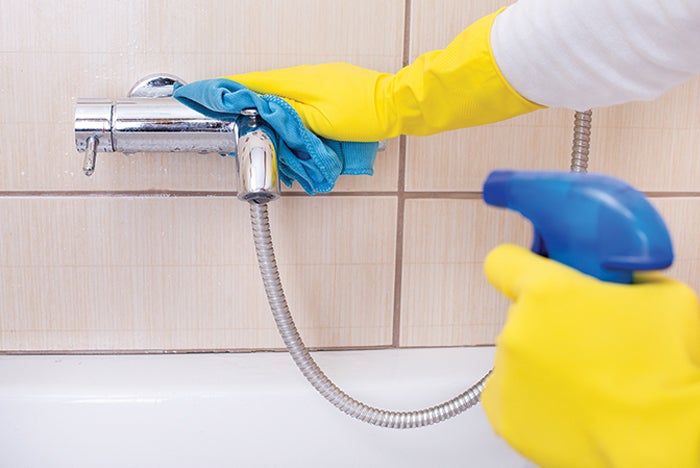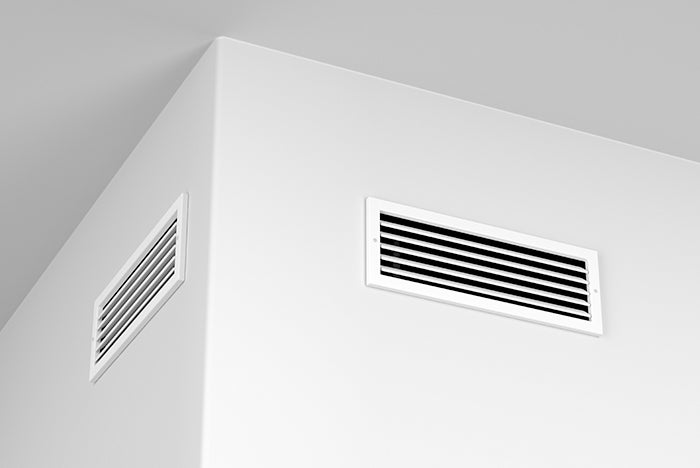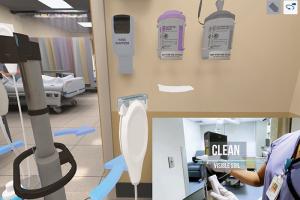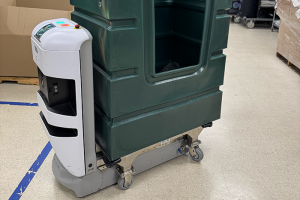A multidisciplinary, multimodal approach for surface selection

Procedures and chemicals used to process fixtures and fittings must be thoroughly reviewed.
Photo by Getty Images
Health care environmental services (ES) directors and managers are being invited to participate in the preplanning of facility renovation and expansion projects as never before.
This is unprecedented and in great part due to the communication, cooperation and collaboration of the professional membership groups of the American Hospital Association and their executive directors.
ES is not only being invited to the table, they are being asked: “What kind of ‘table’ is best suited to processing (cleaning, disinfecting and maintaining) and meeting the needs of patients regarding environmental surfaces?”
Expanded understanding
So, what needs to be done? First, ES professionals should recognize that they don’t know everything about every surface. They must communicate with other disciplines to learn from them.
They must recognize that environmental surfaces don’t just encompass floors and horizontal surfaces. The list is expansive and cannot be addressed fully here, but they include walls, floors, ceilings and windows. Beyond that are door surfaces and finishes, door handles and fixtures, tile grouting, hard and soft furniture finishes, cubicle curtains and their hanging methods, handrails in hallways and restroom facilities, mattress covers, light switches and faceplates, bathroom fixtures, picture frames and how the frames are attached to the walls, furniture finishes and trash receptacles.
Finally, the challenge of health care-associated infections (HAIs) shouldn’t be overlooked. A vigorous commitment to infection surveillance and prevention must remain an essential component of health services. What better reason for ES directors and infection preventionists to be integrated into the process of determining appropriate surfaces and furnishings at the beginning of planning?
Specific areas
A closer look at some of these specific areas includes:
Hospital walls. This is a broad subject that makes up most of the square footage of a hospital, but is most often overlooked and neglected until there is apparent soil or damage. However, walls are contaminated, whether it’s with bare skin and hands, clothing, feet, soiled textiles, bodily fluids, enteral feeding solutions, vomitus, feces or urine.
The two most prevalent wall surfaces in health care are vinyl wallcovering and paint. While the location of the walls typically dictates the choice, aesthetics often control selection rather than upkeep and maintenance.
If vinyl wallcovering is the desired preference, the substrate and adhesive will make a significant impact on the installation and upkeep. All wallcovering adhesives must contain a biocide component. These components are designed to prevent bacterial contamination and mildew/fungal infestation in the dried adhesive and prevent such contamination over years should there be minor moisture behind the wallcovering.
Of course, the first priority is to ensure the integrity of the wall material. It is the responsibility of ES to ensure that cleaning and disinfecting processes do not damage the integrity of the surfaces or the wallcovering seams. Effective communication with the manufacturer of the covering is essential to ensure that accurate information is provided. Then strict adherence to the manufacturer’s directions is necessary.
For painted surfaces, the choices and consequences of the selection are no longer simple. In addition to gloss, semi-gloss, eggshell, matte, water-based or oil-based paint, the ramifications of HAIs and the diverse bacterial and viral causes of morbidity affecting patients and staff must be considered.
Emerging technologies in the paint industry are showing promise in providing safer environments for patients in facilities incorporating antimicrobial paint. These antibacterial paints are regulated by the Environmental Protection Agency. Keep in mind that not all antimicrobial paints are created equally nor are they marketed with the same goals in mind.
One paint manufacturer produces an antimicrobial paint that kills bacteria on the surface after two hours of the bacteria coming and remaining in contact with the painted surface. Other companies have additives that prevent the bacterial organisms from destroying the integrity of the paint.
As with all interventions implemented to produce and maintain safe patient care environments, continuous monitoring and testing of painted surfaces must be implemented to validate the continuing antimicrobial properties of in-place painted surfaces.
Horizontal surfaces. As more hospitals are realizing the benefit of private rooms to positive patient outcomes, including infection prevention and the need for isolation procedures due to a mobile population with more morbidities, renovation and new construction requirements are looking to reduce opportunities for contamination of horizontal surfaces.
Unforgiving chemicals used to decontaminate virulent bacteria that is transferred to surfaces by human touch may negatively affect many natural and composite surfaces typically used in health care due to their initial low cost in manufacturing of furniture and surfaces.
This is also true of some ultraviolet C (UV-C) disinfecting machines. The higher the nanometers (nm), a unit of length used for measuring the wavelength of visible light, the higher the possibility of damage to environmental surfaces.
When considering the efficacy of UV-C machines, the ultimate goal is eradication of pathogens at the lowest effective nm line. The decision of which wavelength generator to use should be made after consulting with an informed multidisciplinary team familiar with all aspects of UV germicidal interventions.
Fixtures & fittings. This covers some of the largest and most prevalent human contact and touch surfaces such as doors, light switches and faceplates, handrails, bedrails, hard furniture surfaces and bathroom fixtures. As with wallcoverings and paint, advances in incorporating metallic compounds such as silver-zeolite, silver ions, copper and zinc into high-touch surfaces are making the health care environment safer.
However, an antimicrobial surface does not mean a clean surface. Antimicrobial surfaces will remain antimicrobial only as long as the surface is dry, clean and microbes come in direct contact with the surface. This means that a contaminated surface — dirt, dust and biofilm — prevents microbes from coming in contact with the surface, thus providing an environment for bacterial growth. Surfaces still must be processed by ES to remove contaminants that foster bacterial and viral growth. This must be shared and understood by every decision-maker.
A comprehensive understanding of the term “safe surfaces” must be applied for the entire environment in which the surface may be impacted.
A safe surface may be free of bacteria and pathogens, but may be toxic to patients, staff and the environment, particularly nanoparticles that may be released from the surfaces during processing and released into the waste stream or leached into ground water.
Beyond simply installing or applying safe surfaces, best practices must be incorporated to process them without damaging or compromising the surfaces or unintentionally exposing patients to products meant to keep them from harm.
Procedures and chemicals used to process the area must be reviewed. For instance, many hospitals have invested in machines that generate activated ionized hydrogen peroxide or hydrogen peroxide vapor. Research on the part of ES must be conducted beyond just reading cut sheets from manufacturers. Processes and chemicals may need changing and ES must bring this information to the planning process.
Similarly, due to the infectious nature of many pathogens, several hospitals are incorporating sodium hypochlorite (bleach) into their processing protocols. Bleach has its benefits and rewards, but is accompanied by risks and costs. Bleach negatively affects most hard and soft surfaces and reduces their life span. Communication, cooperation and collaboration among disciplines is essential for all parties to agree to change the chemicals and ES processing equipment or avoid a new surface material.
As noted, questions also must be asked and answered regarding a machines’ UV-C-generated radiation effect on current or new surfaces as some surfaces may be damaged by mercury-generated UV-C. This is information that ES must bring to the table because other team members might not be aware of it. The information must be science-based and peer-reviewed to be accepted and credible.
The use of products with antimicrobial polymers in hard surfaces, including paint, light fixtures, pull strings for over-the-bed lights, linen carts and ES tools, must be addressed with one’s peers. The benefits of including hard antimicrobial surfaces, such as quartz counters and furniture tops, may have a positive long-term benefit to both patients and a hospital’s profitability.
Flooring. ES knows that floor surfaces receive the most use and abuse of any surface in health care, and are vitally important because they are labor-intensive to maintain and essential to the proper image a facility wants to project.
One of the first things a visitor sees upon entering a health care facility is flooring. An instant impression of the facility is made based on the appearance of the floors. If a floor surface is not appealing, it can negatively influence a patient or visitor. ES professionals and their peers must realize that first impressions are determined at the planning stages.
The next step in flooring selection is involving every stakeholder in determining the appropriate flooring for each environment and those decisions must be made with safety and the life cycle of the flooring in mind.
Too often, well-reasoned decisions to install hard flooring with a matte surface have been criticized by administrators who complain about the lack of shine. A number of negative things happen after that, including increased full-time equivalent (FTE) requirements; costly chemicals that negatively affect waste streams and contribute to volatile organic compounds that may adversely affect vulnerable patients and staff; unnecessary upkeep such as burnishing that releases floor-finish particulates into the air; and refinishing, unexpected wear patterns, delamination, discoloring, replacement and more added expenses.
The Centers for Disease Control and Prevention and its Healthcare Infection Control Practices Advisory Committee have for years held a position that disinfection of hard-floor surfaces in health care facilities is unnecessary, with limited exceptions provided for operating rooms and some isolation precaution patient rooms.
However, the increasing occurrences of multidrug-resistant organisms (MDROs), unexpected antimicrobial shortages occurring around the world that affect U.S. health care facilities, and a significant lack of new antimicrobials are leading health care facilities and researchers to question that position.
Increasingly, ES is being asked to disinfect hard surfaces, with varying degrees of success. Often, disinfectants leave streaks on floors, caused by the disinfectant residue that remains on the floor surface the requisite kill time. This often can be eliminated by having ES return after the floor is dry and damp mop the floor to remove the residue. However, this requires more time than the ES staff have or are granted by nursing, which may be in desperate need for patient rooms.
Disinfectants also may react negatively, on a chemical basis, with floor finishes. These chemical reactions may result in streaks, sticky floors, damaged floor finishes, damage to flat microfiber mops or, at the very least, a haze that must be buffed away.
To overcome these tricky issues, ES professionals must collaborate with infection preventionists, infectious-disease practitioners, health care engineers and facilities directors when discussing emerging diseases and methods to mitigate their effects in health care facilities.
Coming to the table
ES must be prepared to address the current and emerging challenges health care is facing, both clinical and aesthetic.
This can be accomplished only by reading, studying, collaborating and expanding their knowledge base.
When ES professionals come to the table, they must make a positive impact on the discussions and decisions with proven ideas and concepts.




